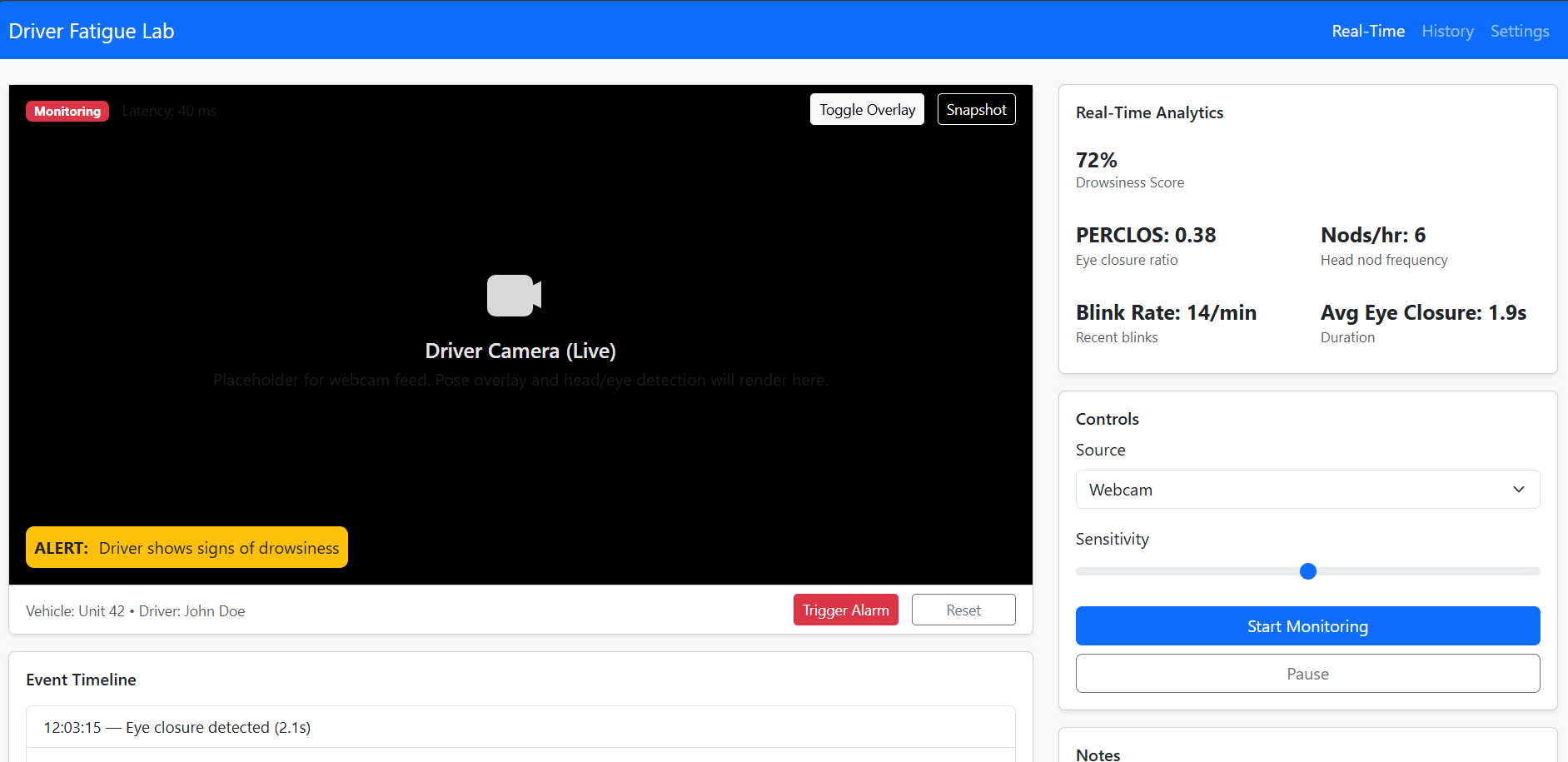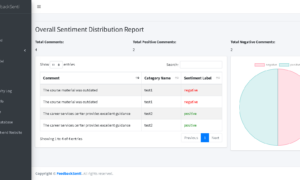Driver Fatigue Detection using PoseNet and OpenCV
Table of Contents
- Driver Fatigue Detection using PoseNet and OpenCV
- Introduction
- Understanding Driver Fatigue and Its Impact
- How AI and Computer Vision Help Prevent Fatigue-Related Accidents
- System Architecture and Workflow
- Technology Stack
- Core Features of the Driver Fatigue Detection System
- 1. Real-Time Pose Tracking
- 2. Blink and Yawn Detection
- 3. AI-Based Alert System
- 4. Dashboard Interface (Optional)
- 5. Data Logging and Reporting
- Example Implementation
- Benefits and Real-World Applications
- Transportation and Logistics
- Public Transportation
- Smart Vehicles and ADAS
- Government and Road Safety Programs
- Challenges and Future Enhancements
- Summary and Conclusion
Introduction
Driver fatigue remains one of the most critical causes of road accidents worldwide. According to the World Health Organization and transport authorities, a large percentage of vehicular crashes are caused by drowsy or inattentive driving. Fatigue impairs judgment, slows reaction time, and reduces focus—often resulting in catastrophic outcomes. Traditional monitoring approaches, such as manual observation or simple sensors, are limited in accuracy and responsiveness.
With the advancement of artificial intelligence (AI) and computer vision, it has become possible to detect fatigue in real time by analyzing visual cues such as eye blinking, yawning, and head posture. In this context, PoseNet and OpenCV offer a promising combination for developing an intelligent, camera-based driver fatigue detection system. PoseNet provides robust human pose estimation capabilities, while OpenCV enables efficient video capture and image analysis. Together, they can help monitor driver alertness and trigger timely warnings—contributing significantly to road safety and accident prevention.

Understanding Driver Fatigue and Its Impact
Driver fatigue occurs when prolonged periods of driving lead to mental or physical exhaustion, reducing alertness and impairing decision-making. Indicators include slow eye blinks, frequent yawns, drooping head movements, and delayed responses. When ignored, these symptoms increase the risk of accidents dramatically.
In industries such as logistics, long-distance transportation, and ride-hailing services, driver fatigue is a recurring safety issue. Even advanced safety systems in vehicles often overlook behavioral aspects like posture and head position. Thus, integrating PoseNet-based pose tracking and OpenCV-driven visual processing into a fatigue detection system bridges this crucial gap—providing a non-invasive, cost-effective, and intelligent solution.
How AI and Computer Vision Help Prevent Fatigue-Related Accidents
AI enables computers to interpret human behavior by analyzing visual data. In fatigue detection, computer vision systems can track specific markers—such as head tilt, eye closure, or body posture changes—that indicate drowsiness.
PoseNet, developed by Google, is a deep learning model capable of detecting keypoints on the human body, including the head, eyes, shoulders, and mouth. By monitoring these keypoints over time, the system can determine whether the driver is nodding off or maintaining proper posture.
Meanwhile, OpenCV (Open Source Computer Vision Library) serves as the backbone for image processing—capturing live video feeds, preprocessing frames, and feeding them into the PoseNet model. When used together, these technologies create a powerful AI pipeline that continuously analyzes the driver’s movements and identifies early signs of fatigue.
System Architecture and Workflow
The proposed Driver Fatigue Detection System operates through a well-defined sequence of steps:
- Video Input – A camera mounted inside the vehicle continuously records the driver’s face and upper body.
- Frame Preprocessing (OpenCV) – Each video frame is processed for noise reduction and normalization.
- Pose Estimation (PoseNet) – The processed frame is analyzed by PoseNet to extract keypoints (eyes, nose, ears, shoulders, etc.).
- Fatigue Analysis Module – The system evaluates these keypoints to detect drowsy behaviors such as:
- Prolonged eye closure
- Repetitive head nodding
- Slouched posture
- Alert System – If fatigue indicators exceed the threshold, an alert is triggered (visual alarm, buzzer, or message on dashboard).
This flow allows real-time monitoring without physically attaching any sensor to the driver, ensuring a non-invasive and efficient fatigue detection process.
Technology Stack
| Layer | Tools/Frameworks | Description |
|---|---|---|
| Programming Language | Python, JavaScript | Core development languages for AI and web integration |
| Pose Estimation Model | PoseNet (TensorFlow.js / TensorFlow Lite) | Detects and tracks body keypoints |
| Computer Vision Library | OpenCV | Handles video capture, image preprocessing, and display |
| Machine Learning Framework | TensorFlow / Keras | Used for training and managing the PoseNet model |
| Hardware | Webcam, Raspberry Pi, or embedded car camera | Captures real-time video of the driver |
| Web Framework (optional) | Flask / Node.js | For alert dashboard or backend communication |
| Alert System | Audio (buzzer) / Visual (LED / message pop-up) | Warns the driver upon detection of fatigue |
This technology stack ensures high performance, real-time detection, and portability across various environments—from small embedded systems to industrial fleet monitoring setups.
Core Features of the Driver Fatigue Detection System
1. Real-Time Pose Tracking
Using PoseNet, the system continuously identifies keypoints on the driver’s face and body, allowing it to analyze head position and facial movements in real time.
2. Blink and Yawn Detection
The system detects fatigue indicators such as slow blink rates and frequent yawns using OpenCV’s face and mouth region tracking, combined with threshold-based logic.
3. AI-Based Alert System
Once fatigue behavior is detected, the system activates a buzzer or display alert, notifying the driver before a dangerous situation occurs.
4. Dashboard Interface (Optional)
For fleet management or research purposes, an optional dashboard built with Flask or Node.js displays real-time driver fatigue data.
5. Data Logging and Reporting
The system records driver behavior, time, and alert frequency for later analysis, enabling companies to design safer driving schedules.
Example Implementation
Here’s an outline of how a basic version of this project could be implemented using Python, OpenCV, and PoseNet (via TensorFlow Lite):
import cv2
import tensorflow as tf
import numpy as np
# Load PoseNet model
interpreter = tf.lite.Interpreter(model_path="posenet_mobilenet_v1_100.tflite")
interpreter.allocate_tensors()
cap = cv2.VideoCapture(0) # Open webcam
while True:
ret, frame = cap.read()
if not ret:
break
# Preprocess frame
img = cv2.resize(frame, (257, 257))
input_data = np.expand_dims(img.astype(np.float32), axis=0)
# Run PoseNet inference
interpreter.set_tensor(interpreter.get_input_details()[0]['index'], input_data)
interpreter.invoke()
# Extract keypoints (simplified example)
keypoints = interpreter.get_tensor(interpreter.get_output_details()[0]['index'])
# Analyze head position
# (Pseudo logic for fatigue detection)
if detect_head_nod(keypoints):
trigger_alert()
cv2.imshow("Driver Fatigue Detection", frame)
if cv2.waitKey(1) & 0xFF == ord('q'):
break
cap.release()
cv2.destroyAllWindows()
This script demonstrates the integration of PoseNet and OpenCV to monitor real-time posture. In a production setup, fatigue detection would use temporal analysis—tracking keypoint movement over several frames to detect nodding or slouching patterns.
Benefits and Real-World Applications
The Driver Fatigue Detection System has immense potential across various industries:
Transportation and Logistics
Fleet operators can deploy this system to monitor long-haul truck drivers, reducing fatigue-related accidents and improving safety standards.
Public Transportation
Buses and taxis can integrate the system to ensure drivers remain alert throughout their shifts.
Smart Vehicles and ADAS
The technology can enhance Advanced Driver Assistance Systems (ADAS), providing an added safety layer in semi-autonomous vehicles.
Government and Road Safety Programs
Authorities can adopt this system as part of road safety campaigns or vehicle inspection protocols.
By integrating PoseNet and OpenCV, this AI-driven system contributes to Vision Zero initiatives—aiming to eliminate traffic fatalities through intelligent technology.
Challenges and Future Enhancements
While promising, implementing fatigue detection systems presents several challenges:
- Lighting Conditions: Night driving or low-light environments can reduce detection accuracy.
- Camera Angles: Variations in camera position or driver height may affect keypoint visibility.
- Model Limitations: PoseNet focuses on upper-body keypoints; integrating facial landmark models like MediaPipe Face Mesh can enhance accuracy.
- Multimodal Integration: Combining visual data with physiological sensors (e.g., heart rate, steering behavior) will yield more robust results.
Future systems may use multimodal AI—merging pose estimation, emotion detection, and sensor data—to achieve near-perfect fatigue recognition even under challenging conditions.
Summary and Conclusion
Driver fatigue is a silent but deadly factor in road accidents, and addressing it requires intelligent, real-time solutions. By leveraging PoseNet for pose estimation and OpenCV for computer vision, developers can create a highly effective driver fatigue detection system that is both non-invasive and accurate.
This AI-powered approach not only improves individual driver safety but also supports large-scale transport systems and public safety efforts. As the automotive industry moves toward smarter, semi-autonomous systems, integrating fatigue detection will become a standard safety requirement rather than an optional feature.
Through continued research and technological refinement, PoseNet and OpenCV can together pave the way for a future of safer roads, alert drivers, and AI-assisted transportation.
You may visit our Facebook page for more information, inquiries, and comments. Please subscribe also to our YouTube Channel to receive free capstone projects resources and computer programming tutorials.
Hire our team to do the project.


